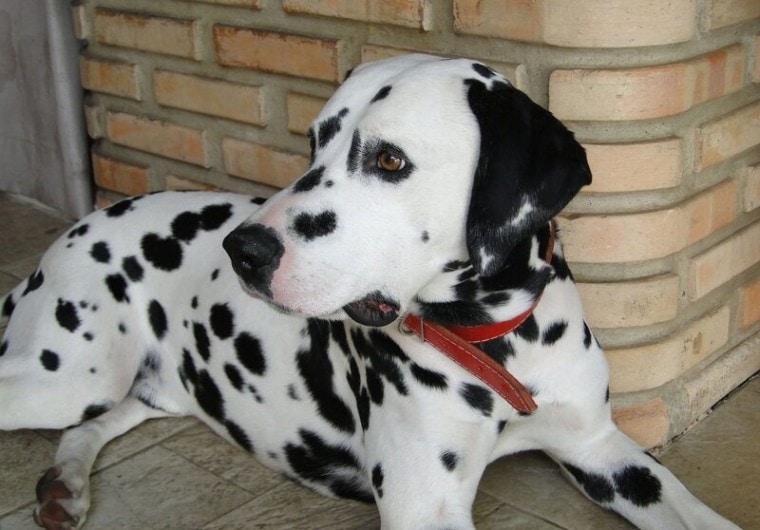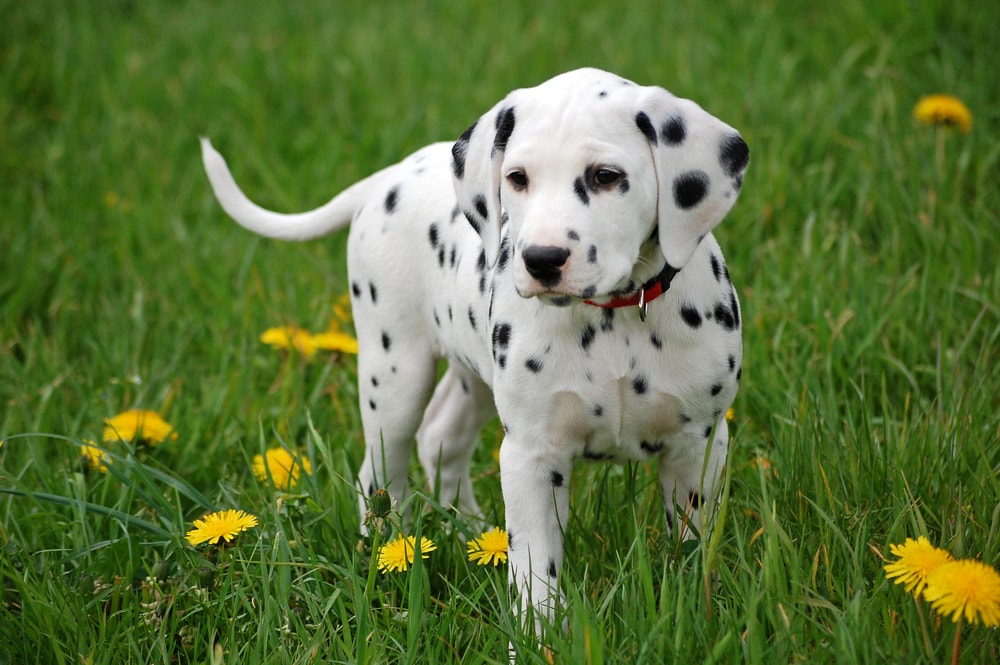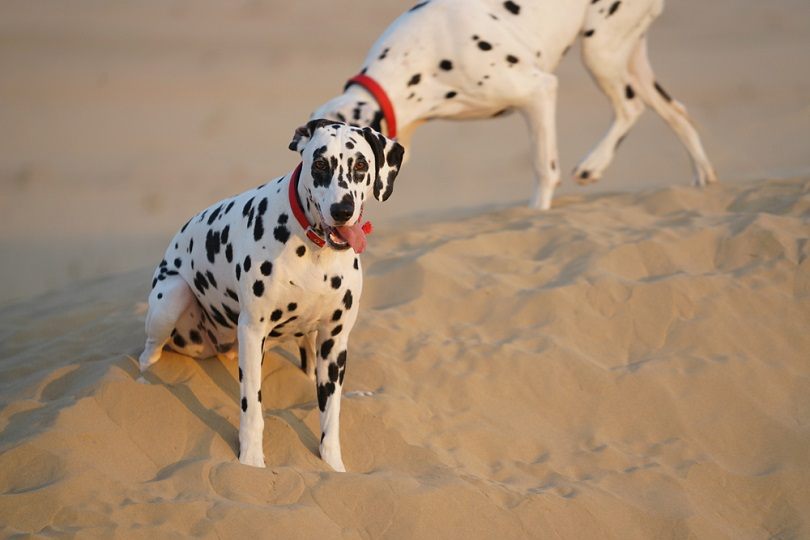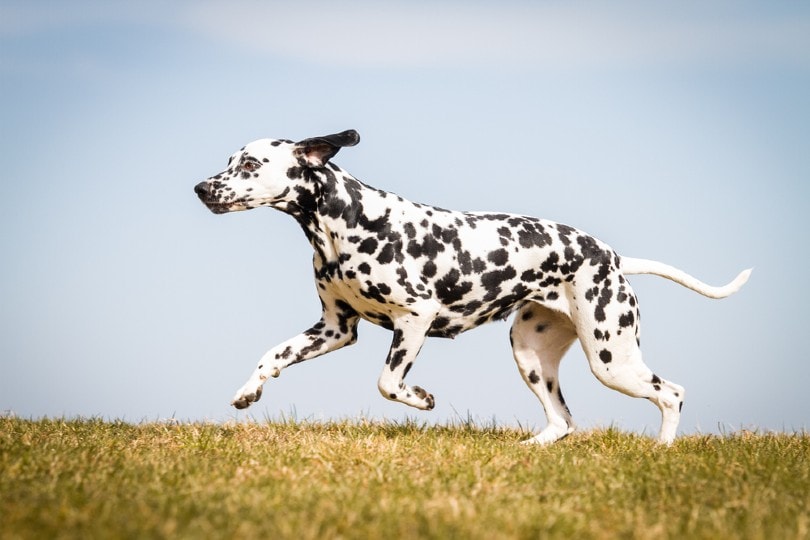
Click Below to Skip Ahead
Dalmatians have a reputation for being dogs who like to hang out in firehouses or fire engines. No, this is not just a mistaken popular perception. When they were introduced to Western Europe and England specifically in the 1700s, they began to be used as coach dogs. They ran alongside carriage cars to protect them from thieves and other assailants. These carriages were also used for fire departments. And so began the popular association of Dalmatians with fire departments. Dalmatians may not actually originate from Dalmatia (there are ancient Egyptian depictions of this breed).
Breed Overview
Height
22 – 24 inches
Weight
45 – 70 pounds
Lifespan
11 – 16 years
Colors
White with black spots or brown spots (liver)
Suitable for
Families, Active lifestyles, Dog owners with some experience
Temperament
Sociable, Affectionate, Intelligent, Loyal
Dalmatians have a reputation for being dogs who like to hang out in firehouses or fire engines. No, this is not just a mistaken popular perception. When they were introduced to Western Europe and England specifically in the 1700s, they began to be used as coach dogs. They ran alongside carriage cars to protect them from thieves and other assailants. These carriages were also used for fire departments. And so began the popular association of Dalmatians with fire departments. Dalmatians may not actually originate from Dalmatia (there are ancient Egyptian depictions of this breed).
But regardless of their origin, they remain today as some of the most intelligent, loyal, and outright fun dogs to be around, especially when they are trained well. However, this requires some serious dedication from the owner of the Dalmatian. Serious consideration should be given to the demand that this pup will place on an owner, especially if the owner has a more sedentary lifestyle. These dogs will fill your life with fun and excitement, but if you can’t keep up, you might find yourself in over your head. So, before you take the leap, here’s what you need to know about our favorite white and black spotted friend!
Dalmatian Characteristics
Dalmatian Puppies

Dalmatians are purebred dogs which generally cost more. If you’re considering having a Dalmatian, keep in mind that they require a lot of responsibility and time commitment. They are highly energetic dogs, meaning they need lots of daily exercise and plenty of mental stimulation to avoid boredom. Dalmatians are easily trainable but they are quite energetic so they will need firm and consistent training sessions.
If you welcome a Dalmatian into your home, be ready for a loyal and affectionate pup wanting to play with you. These dogs are great for active families that can keep up with the Dalmatian’s energy levels.
Temperament & Intelligence of the Dalmatian
Are These Dogs Good for Families? 👪
These dogs are a great choice for families with plenty of energy. If a family is more prone to lounging like a couch potato, this is not the dog for them. They do well with children, but play should always be supervised. They are loyal to their owners and play well with the family, especially if they are trained and socialized well from an early age.
Does This Breed Get Along with Other Pets?
There is no guarantee that dalmatian is going to have a perfectly cooperative experience with your pets. However, if you train them well and socialize them with these same pets when the dalmatians are puppies, there should be no problem.

Things to Know When Owning a Dalmatian:
Food & Diet Requirements 🦴
Dalmatians use a lot of energy, so they require a high-protein diet. But they can also not process purines which are found in beef and liver. Dog food with low or zero purines is optimal for Dalmatians. Make sure to give your Dalmatian organic food that doesn’t have any added fillers in it.
Exercise 🐕
Dalmatians need plenty of exercise. Remember that they were bred to run alongside carriages and could run 20 to 30 miles in a day easily. This means they must not be apartment-living dogs. If you have a big yard, that can work for a lot of them. However, you’ll need to take them out frequently to the dog park, hiking trail, or other excursions.

Training 🎾
It is interesting to note that the demand for Dalmatian puppies increases every time there is a new release in the series of 101 Dalmatians. Many people become elated at the opportunity to own one of these pups. But when they roll about of bed to pour their cup of coffee and this white and black spotted friend is jumping onto them, they might realize that their two lifestyles are incompatible.
Dalmatians require plenty of training from a young age. They need obedience training (shake, sit, roll over, etc.). They also need to be able to run free and work their lungs. The training isn’t necessarily difficult as they are mostly agreeable pups. The challenge is primarily the time commitment. But don’t get frustrated if it’s taking too much time! Dals are sociable and can be sensitive to their owner’s emotions. Be sure to give consistent positive reinforcement for good behaviors while training.
Grooming ✂️
There is a joke often told among Dalmatian owners about their pups shedding. “They shed only twice a year. The first time is for six months in the Spring and Summer. The second time is for six months in the Fall and Winter.” They shed A LOT. You don’t even need to brush them all that much because their coat doesn’t get too long and matted. But you will be picking up a lot of hair, especially if they spend most of their time indoors.

Health and Conditions 🏥
Dals are spry and when exercised and trained properly, they will live a long life with your family, up to 16 years! But they are not without health issues at times. Fortunately, most of these conditions are not insurmountable and since many dals are affected by them, there is a wealth of resources for how to best deal with each condition.
Minor Conditions
Serious Conditions
Male vs Female
The males tend to be taller and stronger. Females will be in heat about twice a year. They may also have false pregnancies and mood swings.
3 Little-Known Facts About the Dalmatian
1. Dalmatians Aren’t Born with Spots
Both black-spotted and liver-spotted Dalmatians are born without spots. Instead, the spots start to develop around 4 weeks of age. In fact, the spots are present at birth but not visible at first.
2. Their Spots Are Spotty
Just as a snowflake has its own unique structure, so the Dalmatian takes spots each with its own size and shape. They are not scattered across the coat evenly (or on the inside of their mouth!).
3. They Are Prone to Inherited Deafness
As good as their health is in other respects, 18% of dals are affected by at least partial deafness.
Final Thoughts
As much as the breed has seen increased popularity due to the 101 Dalmatians series, it hasn’t done great things for the breed. There has been an increased demand for dals since the Disney films have hit theaters. But people focus on the cuteness and forget that these are extremely energetic dogs that take a time commitment. As a result, many newly adopted dalmatians are returned to the humane society. Pups purchased from breeders make their first trip to the humane society after their owners give up.
But if you think this dog is right for you and are fully committed to raising him right, this firehouse dog can be in your family’s home entertaining you for years to come!
Related Reads and Breeds:
- Long-Haired Dalmatian: Info, Pictures, Facts, & Characteristics
- Sharmatian (Shar-Pei & Dalmatian Mix): Info, Pictures, Care & More!
Featured Image Credit: pxfuel







